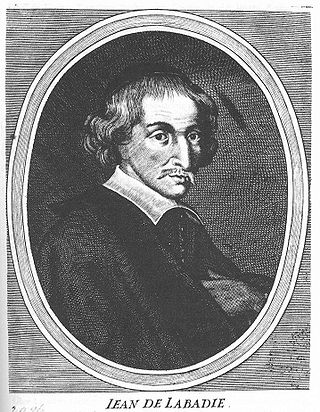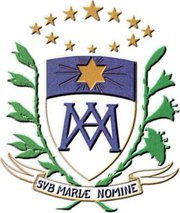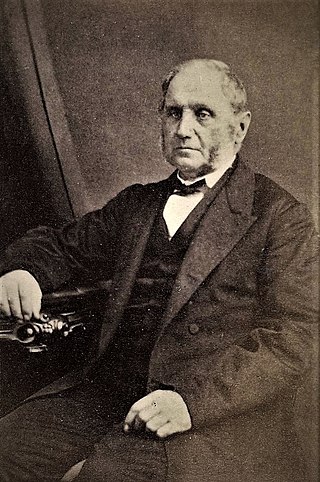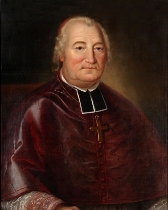
Jean-Baptiste Muard, OSB (Vireaux, 1809-Pierre-Qui-Vire, 1854) was a French Benedictine, reformer, and founder of religious orders.

Jean-Baptiste Muard, OSB (Vireaux, 1809-Pierre-Qui-Vire, 1854) was a French Benedictine, reformer, and founder of religious orders.
Jean-Baptiste Muard was born, the eldest of three sons, on April 29, 1809 in Vireaux to Claude and Catherine Paillot Muard. As a boy he was mentored by the local curé of Pacy-sur-Armançon, M. Rolley, who sponsored him at the Petit Séminaire of Auxerre, which he entered in September 1823. During vacations, Muard and some of his schoolmates would make a pilgrimage on foot to a shrine of Sainte Reine not far from Vireaux. [1] He completed his studies, but the July Revolution of 1830 caused the seminary to close early and the students returned home.
That October Muard entered the Grand Séminaire at Sens and was saddened to discover that, due to the political turmoil, a number of his classmates had reconsidered the advisability of a clerical career at that time. He received the diaconate on December 21, 1833 and was ordained May 4, 1834. After a months visit home, during which he assisted Abbé Rolley, he was appointed curé of Joux-la-Ville. In addition to his pastoral duties, he also began to give instruction to some of the boys, just as Abbé Rolley had taught him. [1]
Although Muard wished to apply for the Foreign Missions, he was then posted to the Church of St. Martin in Avallon [2] to fill a vacancy due to the death of the resident curé. As a favor to a neighboring pastor, he preached a mission in Pontaubert during Advent 1839. It proved so successful, that he began to focus on the potential for Diocesan Missions. Convinced that he should pursue this new direction, he and Abbé Bravard, an associate from the Cathedral at Sens, with the permission of the bishop, commenced a novitiate with the Marist Fathers at Lyon. However, during his time there Muard had occasion to visit John Vianney, the revered Curé d'Ars, who advised him not to join the Marists, but to return to his diocese and conduct diocesan missions. From there, in June of 1841, he made a pilgrimage to Rome and to seek the approval of Pope Gregory XVI. [1]
He founded the French province of the Cassinese Congregation of the Primitive Observance [3] and the Society of Saint Edmund in 1843. In 1850, Jean-Baptiste Muard founded the monastery of Sainte Marie de la Pierre-qui-Vire [4] in the Morvan.
The cause for Muard's beatification was formally opened on 11 May 1928, granting him the title of Servant of God. [5]

Jean de Labadie was a 17th-century French Pietist. Originally a Jesuit priest, he became a member of the Reformed Church in 1650, before founding the community which became known as the Labadists in 1669. At its height the movement numbered around 600 with thousands of adherents further afield. It attracted some notable female converts such as the famed poet and scholar, Anna Maria van Schurman, and the entomological artist Maria Merian.
The Society of Priests of Saint-Sulpice, also known as the Sulpicians, is a society of apostolic life of Pontifical Right for men, named after the Church of Saint-Sulpice, Paris, where it was founded. The members of the Society add the nominal letters PSS after their names to indicate membership in the Congregation. Typically, priests become members of the Society of the Priests of St. Sulpice only after ordination and some years of pastoral work. The purpose of the society is mainly the education of priests and to some extent parish work. As their main role is the education of those preparing to become priests, Sulpicians place great emphasis on the academic and spiritual formation of their own members, who commit themselves to undergoing lifelong development in these areas. The Society is divided into three provinces, operating in various countries: the Province of France, Canada, and the United States.

Peter Louis Marie Chanel, SM, was a Catholic priest, missionary, and martyr. Chanel was a member of the Society of Mary and was sent as a missionary to Oceania. He arrived on the island of Futuna in November 1837. Chanel was clubbed to death in April 1841 at the instigation of a chief upset because his son converted.

Jean-Baptiste-Antoine Ferland was a French Canadian historian.

The Society of Mary, better known under the name Marist, is a religious congregation under pontifical right.

Jean-Jacques Olier, S.S. was a French Catholic priest and the founder of the Sulpicians. He also helped to establish the Société Notre-Dame de Montréal, which organized the settlement of a new town called Ville-Marie in the colony of New France.

Jean-Baptiste François Pompallier was the first Roman Catholic bishop in New Zealand and, with priests and brothers of the Marist order, he organised the Roman Catholic Church throughout the country. He was born in Lyon, France. He arrived in New Zealand in 1838 as Vicar Apostolic of Western Oceania, but made New Zealand the Headquarters of His Catholic Mission.

Pierre Beaubien was a physician and political figure in Canada East, Province of Canada. Trained in medicine in France, he practised and taught medicine in Montreal. He was involved in real estate development in Montreal, contributing to the creation of Outremont. He served two partial terms in the Legislative Assembly, the lower house of the Parliament of the Province of Canada, as a member of the French-Canadian Group under the leadership of Louis-Hippolyte LaFontaine.

Pierre Denaut was the tenth bishop of the Roman Catholic diocese of Quebec and the last before it became an Archdiocese. He served as bishop from 1797 to 1806.

The Seminary of Quebec is a Catholic community of diocesan priests in Quebec City founded by Bishop François de Laval, the first bishop of New France in 1663.

The Diocese of Moulins is a Latin diocese of the Catholic Church in France. The episcopal see is located in the city of Moulins. The diocese comprises all of the department of Allier in the region of Auvergne.
Vireaux is a commune in the Yonne department in Bourgogne-Franche-Comté in north-central France.

Abbé Jean-Louis Le Loutre was a Catholic priest and missionary for the Paris Foreign Missions Society. Le Loutre became the leader of the French forces and the Acadian and Mi'kmaq militias during King George's War and Father Le Loutre's War in the eighteenth-century struggle for power between the French, Acadians, and Miꞌkmaq against the British over Acadia.

Michel-Édouard Méthot was a French-Canadian Roman Catholic churchman, educator, and early rector of Université Laval.

Abbé Pierre Antoine Simon Maillard was a French-born priest. He is noted for his contributions to the creation of a writing system for the Mi'kmaq people of Île Royale, New France. He is also credited with helping negotiate a peace treaty between the British and the Mi'kmaq that resulted in the Burying the Hatchet ceremony. He was the first Catholic priest in Halifax, Nova Scotia, and is buried in the St. Peter's Cemetery, in Downtown Halifax.

Guy de Fontgalland, Servant of God, was regarded in the inter-war period as the youngest potential Catholic saint who was not a martyr. His beatification process was opened on November 15, 1941, and suspended on November 18, 1947.

Jean-Baptiste-Antoine Lassus was a French architect who became an expert in restoration or recreation of medieval architecture. He was a strong believer in the early Gothic architecture style, which he thought as a true French and Christian tradition, and was opposed to the classical Graeco-Roman styles promoted by the academic establishment.

Joannes Baptista or Jean-Baptiste Malou (1809–1864) was a Belgian theologian who became bishop of Bruges.
The Prix Juteau-Duvigneaux of the foundation of the same name, was an annual prize in philosophy awarded by the Académie française. Starting in 1896, it was awarded to the author or authors of works in Ethics, especially from the Catholic point of view.

Saint Onenne is a local Breton saint whose cult exists only in Tréhorenteuc. The church of the municipality partly bears her name. Initially associated with the image of a "Celtic saint," her cult has been linked to symbols of the swan-maiden or the bird goddess close to the goddess Ana, hence her connection with ducks and geese, birds that have retained an important place in her hagiography. Although she is said to have lived in the 7th century, her first written mention dates back to the 11th century. Over time, the removal of original elements brings her cult closer to that of the Virgin Mary associated with grace and purity.